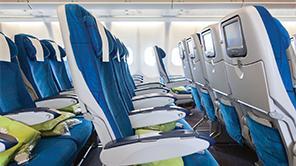How Modular Comfort Headrests Improve Automotive Seating

In order to differentiate themselves in the marketplace, automotive manufacturers are increasingly adding comfort-driven features such as adjustable wings and new shapes to vehicle headrests to complement new interior design trends. As headrests constantly evolve with the latest design trends in the automotive industry, it is essential that engineers anticipate and prepare for changes to styling throughout the design process – especially when it improves the end user experience.
Engineers must balance aesthetics and comfort-driven features with functional aspects that are essential to vehicle design, such as safety and reliability, while eliminating warranty issues and extra costs. In designing headrest applications, the key is to create a reliable core design that withstands the test of time and delivers effortless operation.
The mechanics of headrest design must be robust and cost-effective on the inside, while end user preferences require that it be comfortable and reliable on the outside. These factors pose a challenge to engineers, who must integrate these specifications into a design which is often used in vehicle production for up to 15 years.
From conception to execution, automotive engineers are tasked with designing headrest solutions that can change directions with design and styling adjustments. By adopting an adaptable, validated comfort headrest positioning system, automotive engineers can anticipate the fluctuating preferences of studio designers – whether it involves changes to torque requirements or mounting style modifications.
Balancing Driver Comfort and Production Cost
High production volume within the automotive segment requires high-quality solutions, which often makes headrest design a complex, costly process. However, as the automotive market continues to explore new interior design trends, automotive manufacturers must balance this demand for comfort styling with reliability, safety and cost.
Headrest design must not only be cost effective, easy to assemble and sustain quality in the long-term – it must also cater to ergonomic necessity. In a 2011 J.D. Power and Associates U.S. Seat Quality and Satisfaction Study, it was reported that 6.2 percent of new-vehicle owners report problems with their vehicle seats, with headrest adjustment as the most frequently cited seat related issue.
According to Allan Dix, research director of automotive product quality at J.D. Power and Associates, “New-vehicle owners have had more problems with the headrest adjustment controls than with any other part of the seat. Customers are having problems getting the headrest adjusted or setting it to a comfortable position.”
Because end users desire headrests that are supportive and easy to maneuver, and automotive OEMs must control costs associated with production, design engineers often face the difficult decision of sacrificing comfort for basic functionality. To overcome this challenge, automotive OEMs have shifted more towards the adoption of a modular platform strategy for headrest design, which involves carrying over the same core concept for each new application, while still placing significant focus on changes to the exterior styling of the headrest itself.
By choosing one platform that can be integrated into a multitude of designs, designers have the freedom to style the look and feel (i.e., foam padding and upholstery) of the headrests according to industry design trends, while still putting out a quality end product that is ergonomically pleasing to the end user.
Southco’s Modular Comfort Headrest Solutions
Southco’s Modular Comfort Headrest solutions for the automotive industry feature Southco’s integrated positioning technology, which provides reliable and flexible constant torque capabilities in a small package, allowing it to be seamlessly integrated into OEM seat designs.
Headrest assemblies available to automotive manufacturers in today’s market are limited in their flexibility and installation capabilities. Many of these predesigned options fall short of design needs due to generic specifications and bulky hardware, such as large hinges that can take up too much space within the mechanism to provide optimum headrest operation and positioning. Engineers may instead choose to create their own solutions in house, taking on design, validation and testing costs, which in many cases contributes to the overall production cost of the vehicle.
Southco’s Comfort Headrest is a fully-validated solution that can be designed to meet the unique performance requirements of each vehicle and provides consistent torque over high cycle life requirements. The integrated torque hinges within the Comfort Headrest provide best-in-class consistent, operating effort in the smallest package requirements. This small size enables designers to execute previously unattainable headrest styles.
Supplied as a molded assembly, the Comfort Headrest encapsulates and hides the hinging mechanism between the wings for enhanced aesthetic value. The small diameter of the hinge cartridges enables enhanced flexibility that is difficult to achieve with a nut and bolt. The Headrest can also be designed with a snap-in feature that allows it to be quickly assembled to the headrest structure without screws or rivets.
The Comfort Headrest is designed to integrate constant torque functionality into a molded assembly and enables users to easily position the finished headrest and hold it securely at any desired angle, whether it’s fully opened, partially closed to support the head and neck, or anywhere in between.
Key Product Features and Benefits
Southco’s Modular Comfort Headrest is designed with best-in-class features that aid in the assembly process, reduce labor time and eliminate tooling investment, making it a low-risk, versatile option for integration into seating designs. The in-mold assembly process makes the mechanism especially practical for the automotive industry’s high volume applications, new designs and design refreshes.
The Comfort Headrest offers the following benefits:
- Smooth operation and better positioning – The smooth operation provided by the in-molded hinges gives the end user the perception of quality. The integrated constant-torque hinges allow the user to easily position the headrest with minimal force.
- Asymmetric torque eliminates the need for readjustment – Asymmetric torque allows engineers to specify various operating efforts in different directions of motion, allowing end users to easily pull the wings forward for adjustment, yet still be supported when resting their full weight against it.
- Mobility unaffected by temperature changes – The engineering of the Comfort Headrest helps to protect against changes in operating effort caused by temperature changes. Robust construction and materials ensure the functionality of the design in changing environments.
- Extends service life – The reliable design of the Comfort Headrest ensures functionality throughout the service life of the vehicle. The hinging technology is maintenance free, allowing the end user to reposition the headrest as often as necessary and it will remain in position each time.
- Reduces production costs – The Comfort Headrest features simple integration of constant torque functionality into injection molded products for a complete solution. Its compact, over-molded design reduces assembly costs and ensures reliability throughout the production process.
Conclusion
As automotive industry trends continue to shift and evolve, engineers must anticipate design changes by implementing a validated, core mechanism solution which allows for the flexible positioning and mounting of headrests in new vehicle design and production. Additionally, the positioning solution must be designed to withstand repetitive use and outlast the life of the vehicle.
By selecting Southco’s Modular Comfort Headrest, automotive manufacturers will ensure best-in class functionality and quality in their seating applications, as well as reduced labor and production costs, while providing the comfort and ergonomic advantages that end users desire.



